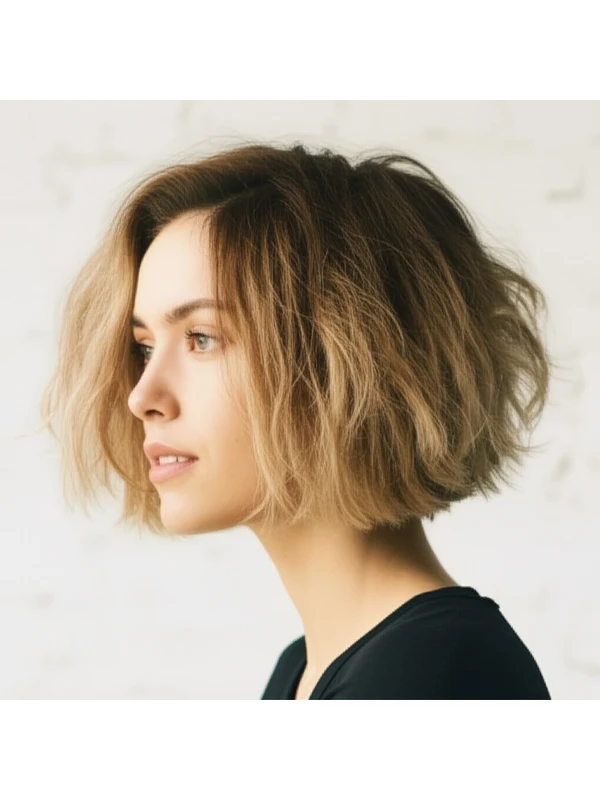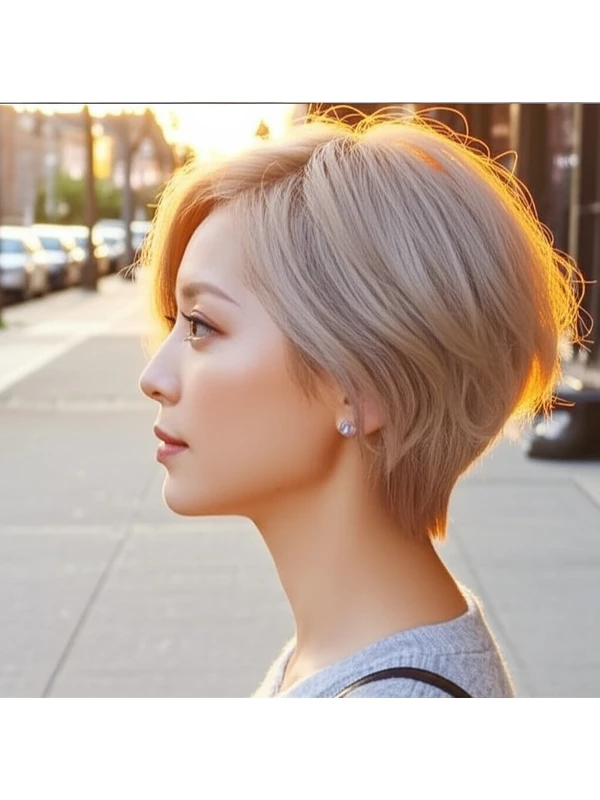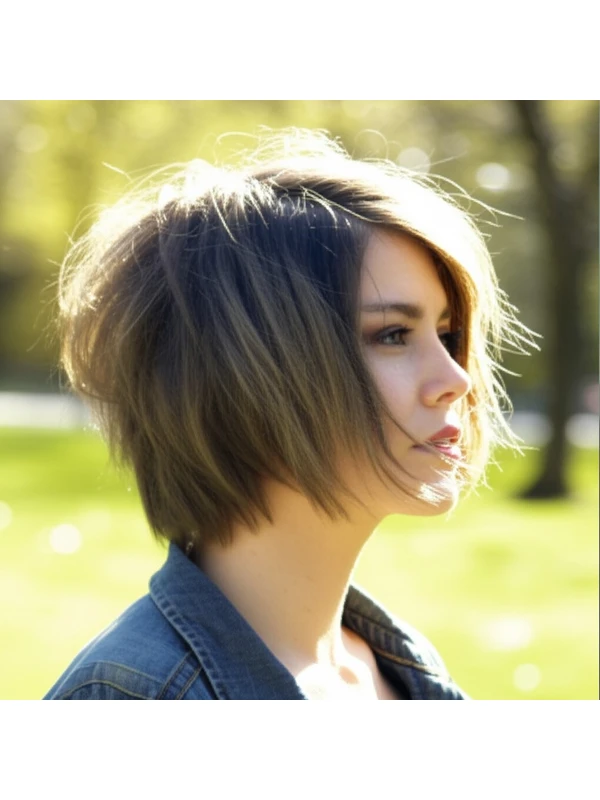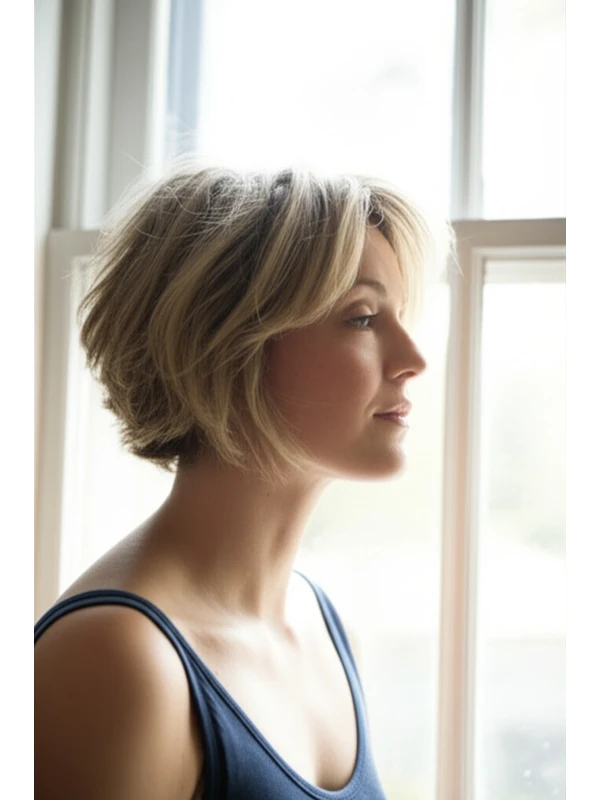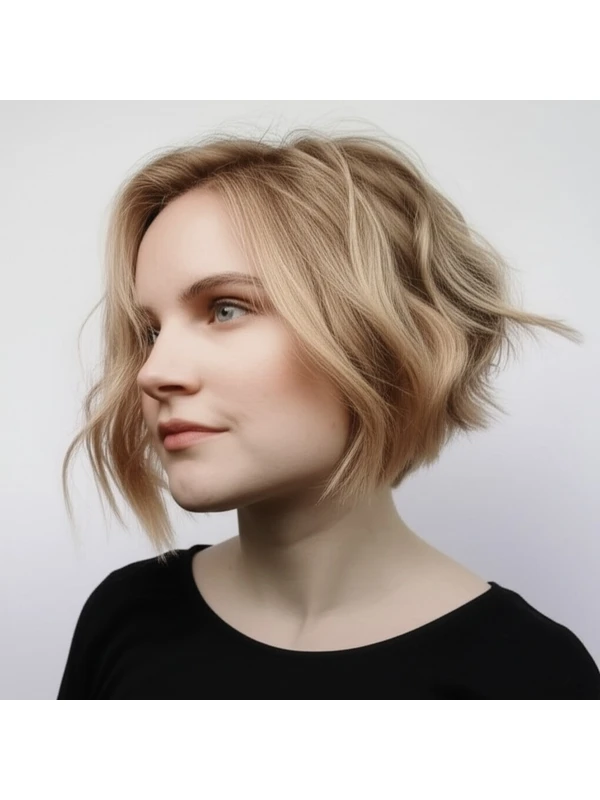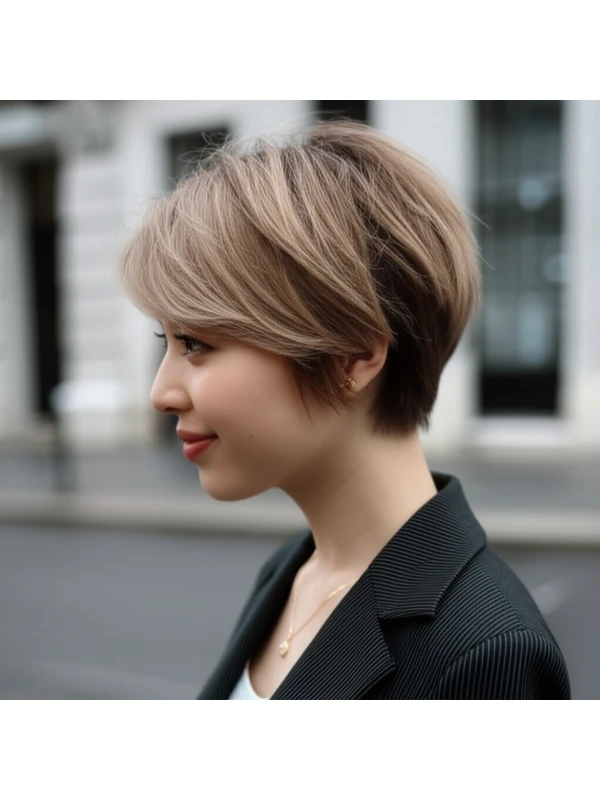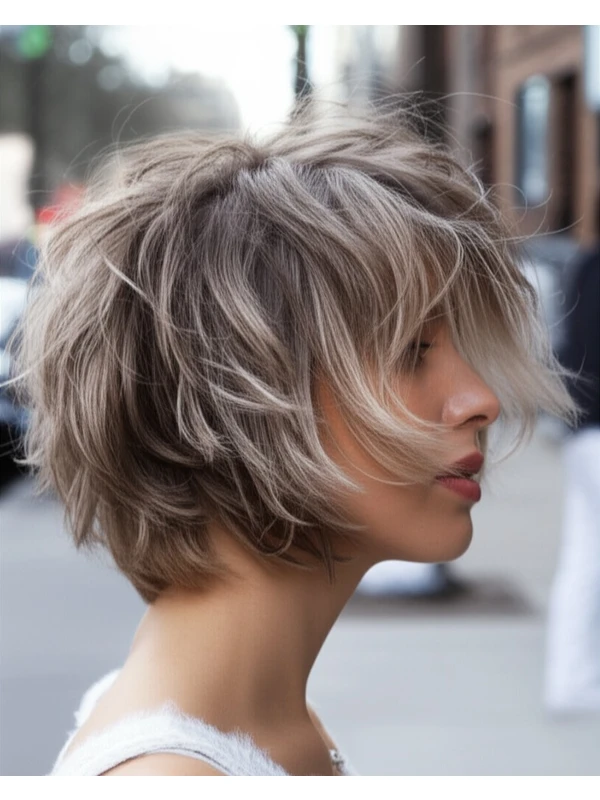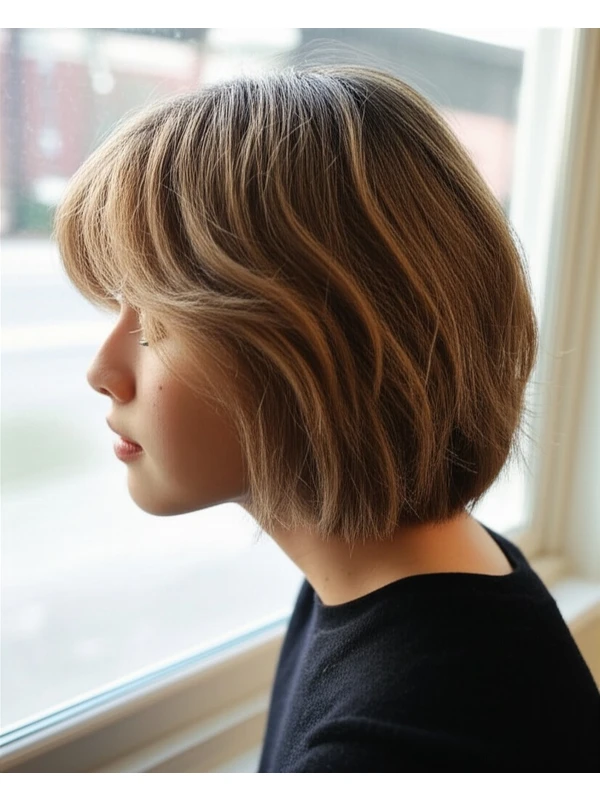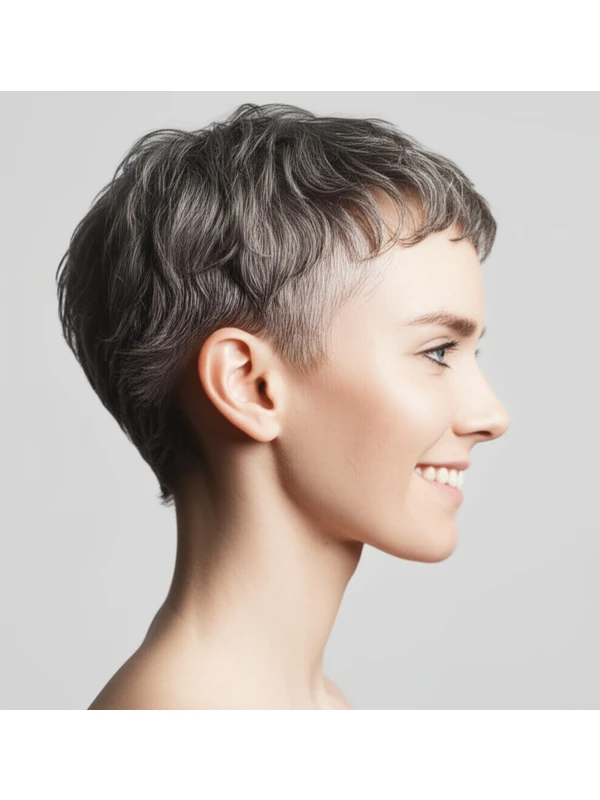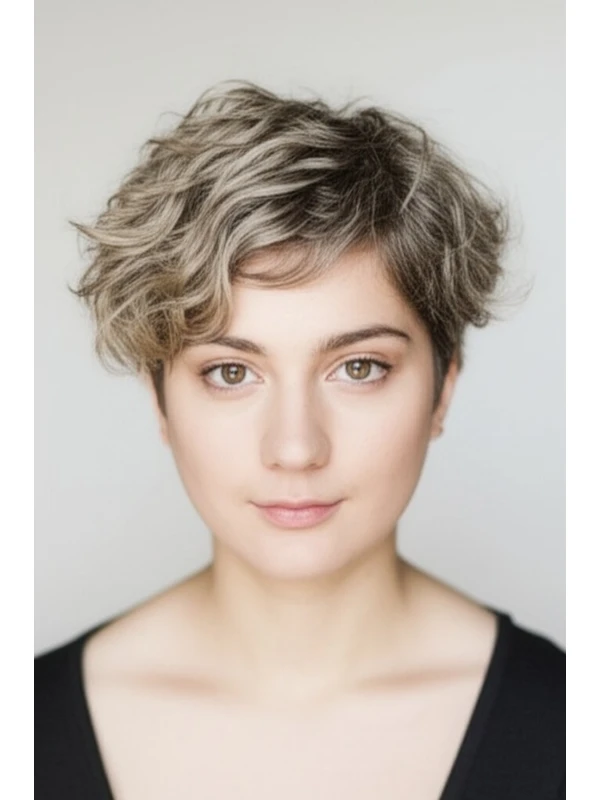#The Wedge Cut: A Bold & Modern Classic
The wedge cut is back! This iconic hairstyle has evolved from its retro roots into a fresh, modern look that can flatter many face shapes and hair types. But what exactly is a wedge? Let's dive in to everything you need to know about this striking style.
#1) Background & Definition: What Makes a Wedge a Wedge?
The wedge cut is characterized by its sharp angles and dramatic shaping, resembling (you guessed it!) a wedge of cheese. It’s essentially shorter at the sides and nape of the neck, gradually increasing in length towards the crown of the head. Think strong lines and defined edges – this isn't a soft or blended style!
Key Features:
- Geometric Shape: The defining characteristic is its angular, almost architectural form.
- Contrast: A significant difference in length between the shortest point (usually at the nape) and the longest (at the crown).
- Volume at the Crown: The wedge typically creates volume on top, drawing attention upwards.
Typical Length Ranges:
The length can vary dramatically!
- Short Wedge: Nape is very short (1-2 inches), with hair reaching just below ear length at the crown. Bold and edgy.
- Medium Wedge: Nape slightly longer (2-3 inches), hair reaches chin or jawline length at the crown. A versatile, balanced option.
- Longer Wedge: Nape around 3+ inches, hair reaching shoulder or collarbone length at the crown. Softer and more blended, but still retains wedge elements.
Alternative Names:
You might also hear it called a:
- Pageboy (a softer, rounded version)
- Rounded Wedge
- Modern Wedge
#2) Face Shape Fit: Finding Your Perfect Angle
The key to rocking a wedge is understanding how its angles play with your face shape. Here's a breakdown:
- Oval: Lucky you! The wedge generally looks fantastic on oval faces because it complements their balanced proportions. A blunt fringe (bangs) can add even more definition.
- Round: A wedge cut can work, but strategic styling is key. Avoid too much volume at the sides – focus on height and a strong center part to elongate the face. Longer, angled bangs that sweep to the side are often flattering.
- Square: The angles of a wedge can soften a square jawline. A softer, slightly rounded edge instead of a harsh angle will be more forgiving. Side-swept fringe is ideal for softening edges.
- Heart: A wedge with layers and volume at the crown helps balance a wider forehead and narrower chin. Chin length or slightly longer styles work well to add fullness. Avoid very short, blunt bangs which can accentuate the width of your forehead.
- Diamond: Similar to heart shapes, wedges that create height and soften angles are best. A textured fringe (not too blunt) can help balance a wider cheekbone area.
- Oblong/Long: A wedge with more volume at the sides is crucial to visually widen a long face. Avoid styles that emphasize verticality even further. Consider shorter, layered bangs to break up length.
#3) Body Proportions & Height Guidance: Sizing Up Your Wedge
The best wedge style isn't just about your face – it’s about how the cut interacts with your overall body shape and height.
- Petite: A shorter, more cropped wedge can look overwhelming on a petite frame. Opt for a medium-length version that doesn't overpower your features.
- Average Height: Most lengths work well! Experiment to find what feels most comfortable and suits your style.
- Tall: Longer versions of the wedge (chin or shoulder length) can balance your height without looking disproportionate.
- Narrow Shoulders: A wider, more voluminous wedge at the crown will visually broaden narrow shoulders.
- Broad Shoulders: Avoid excessive volume on top, as it can further accentuate broadness. A slightly sleeker, tapered wedge is a better choice.
- Short Neck: Shorter wedges with height at the crown help to elongate the neck.
- Long Neck: Medium-to-longer lengths are generally more flattering for longer necks, as they provide visual balance.
#4) Works Best With Hair Types & Densities: Finding Your Wedge Sweet Spot
The wedge isn’t one-size-fits-all when it comes to hair texture and density.
- Straight: The wedge shines on straight hair! It allows for clean lines and sharp angles that really define the shape.
- Wavy: Wavy hair can work beautifully, but requires careful styling to manage natural movement. A texturizing product will help enhance the shape without frizz.
- Curly/Coily: While less common, a wedge can be adapted for curly and coily textures! The key is to consider shrinkage – what looks like a medium length when dry can become much shorter when wet. Work with your stylist to find the right balance of layers and shape that works with your curl pattern.
- Fine Hair: A wedge adds volume, which is great for fine hair. Avoid overly heavy layering, as it can make hair look even thinner.
- Medium Hair: The most versatile density – a wide range of wedge styles will work well.
- Thick Hair: The wedge’s strong shape helps to control thickness and prevent a bulky appearance. Layering is essential to remove weight.
Shrinkage Note for Curls & Coils: Remember, curly and coily hair shrinks! A style that looks like 8 inches dry might only be 4-5 inches when wet. Communicate this clearly with your stylist.
#5) Styling Variations: From Sleek to Textured
The beauty of the wedge is its adaptability!
- Sleek vs. Textured: A sleek, polished wedge screams sophistication. A textured wedge (using texturizing products and air-drying techniques) has a more modern, undone vibe.
- Middle vs. Side Part: A center part emphasizes symmetry and structure. A side part adds softness and movement.
- Fringe Variations: Blunt bangs create a bold statement; angled or wispy bangs soften the look. Curtain bangs are also an increasingly popular choice for adding face-framing interest.
- Occasion Styling:
- Casual: Air dry with texturizing spray or mousse.
- Office: Sleek and polished, using a flat iron to create sharp lines.
- Evening: Add volume at the crown with root lifter and style with a round brush for extra drama.
#6) Maintenance: Keeping Your Wedge Sharp
- Trim Cadence: Every 4-6 weeks is typical to maintain the shape.
- At-Home Routine: Gentle shampoo, moisturizing conditioner, leave-in treatment (especially important for curly/coily hair).
- Heat vs. Air Dry: Heat styling helps define the angles, but excessive heat can damage hair. Alternate between air drying and using a flat iron or round brush.
- Product Checklist:
- Shampoo & Conditioner (suited to your hair type)
- Leave-in Conditioner (for moisture and detangling)
- Root Lifter/Mousse (for volume)
- Texturizing Spray/Pomade (for definition, optional)
- Heat Protectant (if using heat tools)
- Estimated Daily Styling Time: 15-30 minutes, depending on desired style and hair type.
#7) Grow-Out Roadmap: The Wedge Evolution
- Months 1-3: The wedge maintains its defined shape. Regular trims are crucial to prevent it from looking blunt or awkward as the length grows.
- Months 4-6: The angles soften slightly, and you may notice more natural movement. Consider adding subtle layers for a softer transition if desired.
#8) Color Pairings: Enhancing Your Wedge
- Cool Undertones (ash blonde, silver, cool brown): These shades enhance the sharp lines of the wedge and create a modern, edgy look.
- Warm Undertones (golden blonde, caramel brown, copper): Add warmth and dimension to soften the angles.
- Low-Commitment Options: Balayage or highlights can add depth and dimension without a drastic color change.
#9) Season & Occasion Guide: Styling for Every Moment
- Spring/Summer: Lighter styling products, air drying, softer textures.
- Fall/Winter: More structured styles with root lift and shine serums.
- Work: Sleek and polished.
- Weddings: Voluminous updo or half-up style showcasing the wedge shape.
- Parties: Experiment with texture, volume, and bold accessories.
#10) Cost & Time: Salon Details
- Salon Time: Expect a consultation plus cut to take anywhere from 45 minutes to 1.5 hours depending on complexity and stylist experience.
- Price Range: The cost will vary considerably based on location and salon, but expect it to be in the mid-to-high range compared to simpler cuts.
#11) Pros & Cons: Weighing Your Options
Pros:
- Bold and stylish statement.
- Can add volume and dimension.
- Versatile with styling options.
- Flattering for many face shapes (with the right adjustments).
Cons:
- Requires regular trims to maintain shape.
- Styling can be time-consuming, especially for certain hair types.
- Not as forgiving if not cut correctly – a bad wedge is really noticeable!
#12) Salon Consultation Script: Your Questions Answered
Here are some questions you can bring up during your salon consultation to ensure you get the wedge of your dreams:
- "I'm interested in a wedge cut. Can we discuss what length and angle would best suit my face shape?"
- “How will this style work with my hair texture/density?”
- "Can you show me some examples of wedges on people with similar hair to mine?"
- "What styling products do you recommend for maintaining the wedge's shape at home?"
- “How often should I come in for trims to keep the shape consistent?”
#FAQs: Your Wedge Questions, Answered
- Can a wedge work with curly hair? Yes! It requires careful layering and consideration of shrinkage but can be adapted.
- Is a wedge difficult to style? It depends on your desired look. Sleek styles require more effort than air-dried textures.
- Will I need bangs with a wedge? Not necessarily, but they often enhance the overall look and soften angles.
- How much will my hair shrink after a wedge cut? Curly/coily hair can shrink significantly (up to 50%), so discuss this with your stylist beforehand!
- Can I do a DIY wedge cut at home? It’s not recommended unless you are an experienced hairstylist. The angles require precision.
- What if my face shape isn't "ideal" for a wedge? A skilled stylist can modify the style to flatter your features – communication is key!

